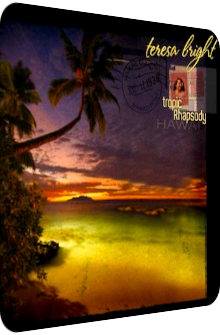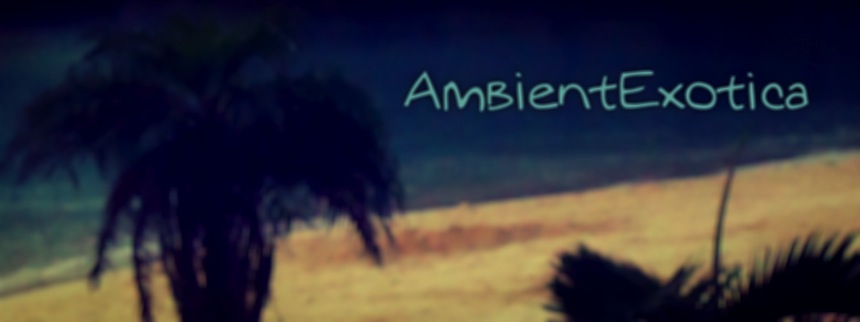
Teresa Bright
Tropic Rhapsody
2008
Teresa Bright is a popular Hawaiian singer, former vocalist for Don Tiki and a ukulele player whose Hapa Haole-based career started in the early 80’s, and though these Hawaiian songs with English lyrics are still in the spotlight, her album Tropic Rhapsody, released in December 2008 on the Honolulu-based Mountain Apple label, provides an enormous dreamscape of 12 tracks. Rarely did I encounter a Hawaiian vocal album whose jazzed up front artwork fits so perfectly with the music. Tropic Rhapsody is a wonderfully entrancing Oceanic Pop artifact with a clear focus on the mellower, carefree and transfiguring side of the genre. Exotica fans are lured with well-known material, and while the used pool of instruments is not particularly exotic per se, the occasional use of guiros, bongos and the much steadier integration of ukuleles and vibraphones in unison with Teresa Bright’s cozy vocals make it a particularly wraithlike album that oscillates between twilight, dusk and night. Occasional sunbursts are featured as well, but a reverie-resembling state is always maintained, in fact so much so that I am hesitant in using the genre term Hapa Haole.
Whatever composition Bright presents, she is keen on keeping the usual genre inheritances such as Latin rhythms, jazzy sequences and swinging Bossa Novas out of sight; all of these styles are included at some point, but they are more or less short segues or careful infusions rather than framing devices. Even if one prefers instrumental versions of Exotica classics as I do, Mrs. Bright’s voice is stunningly dulcet and definitely silky, conflating with the auroral incandescence of the nightly dioramas. Fans of Lisa Ono’s Exotica album Bossa Hula Nova of 2001 are surely among the intended target group as well, and Bright even comes up with a rendition that Lisa Ono chose as well. So without further remarks, here is a closer look at all of Teresa Bright’s 12 renditions on Tropic Rhapsody.
Alex Anderson’s I’ll Weave A Lei Of Stars opens the disc in a poeticized mellow Oceanic sunset version with a distinctly carefree piano aorta and silkened bongos plus cymbals whirring around Teresa Bright’s enchanting vocals that are carefully embedded in-between the setting, never outshining the arrangement nor being put to the back by the instruments. Once the violins set in, the assertion of kitsch is admittedly close at hand, but these wonderful evening strings augment the density of this laid-back rendition very well. The next song is Silhouette Hula, originally written by Steve Graham and Danny Kalauawa Stewart, and keeps the tempo and setting of the opener alive, and even though it is at the end a different song, Bright’s take on Silhouette Hula feels more like an addendum to I’ll Weave A Lei Of Stars, albeit a good one: the fizzling cymbals are more visible, the Balearic nylon-stringed guitar is a bit out of place in my opinion, but thankfully camouflaged soon enough by the gorgeous polyphony of the paradisiac spiraling violin motif which is the true signature element… next to Bright’s vocals, of course.
Bright’s following interpretation of Charles E. King’s Kaimana Hila opens the soundscape thanks to the golden-shimmering riffs on her ukulele and a superb concoction of alto flutes and glistening pastel-colored vibraphone droplets. In contrast to Lisa Ono’s sun-lit take, Teresa’s infinitesimally more dark-velvet voice depicts a nocturnal setting of the same scenery in tandem with the arrangement of the instruments. It’s a draw, I like both versions equally and place them next to each other quite often.
While the lyrics of Ralph Rainger’s and Leo Robin’s 1937 smash hit Blue Hawaii are presented here in a pitch-perfect surrounding – "The night is young, and so are we" meshes perfectly with the intrinsic style of Tropic Rhapsody since only the acoustic guitar twangs illuminate the delicate twilight beach scenery –, Hugh William’s Red Sails In The Sunset is the most phantasmagoric tune of the whole album thanks to the omission of the percussion, with only a few double bass backings kept intact in order to accentuate Bright’s firm interpretation. The violins and the dew of the pianos work flawlessly, but it is the surprisingly majestic violin cascades and the vibraphone capsules which rev up the cinematic scope of this solemn piece ever so slightly, putting the ephemeral sunburst version of Harry Kaapuni & His Royal Polynesians on their 1960 album Aloha Hawaii to shame. Sweet Leilani by Harry Owens is the only song in this string where an uplifting sunrise-infused tropical scheme is established thanks to the warmhearted acoustic guitar backings; even the vibraphone distributes large doses of daylight.
Branching off into more diverse and quite imaginative fields, Bright’s take on both Jack Pitman’s Exotica gold standard Beyond The Reef with its polyphonous vocals, aqueous maracas and lacunar – or better still: lunar – bongo-traversed piano structure, and her interpretation of Prince Leleiohoku’s Tahauala with its upbeat boosted percussion layers and the unexpectedly metropolitan piano chords in bebop style confront the listener with a decided shift away from the gossamer sunset aura as presented in the first six tracks. Pagan Love Song is no different, it is even outright eclectic: Nacio Herb Brown’s and Arthur Freed’s eternal classic is unleashed in the form of a sizzling-hot dreamlike mirage, with the classic drums, bass guitars and various shakers and cymbals forming a thicket through which the polyphonous euphony of Teresa Bright’s and the backing singer’s vocals are connected. The jumpy but mellifluous piano accents, the whirling vibraphones and the double bass melodies make it the jazziest offering.
Unsurprisingly, Teresa Bright returns to moony climes with Bob Nelson’s Hanalei Moon which presents the most stripped-down soundscape and thus refers back to the glitz of variety as the album nears its end; a piano arrangement of the languorous kind, Bright’s vocals truly shine through every fissure in this alcove-filled soundscape, successfully referring back to the nightly beauty of Hanalei Bay. Whereas Ned Washington’s and Agustín Lara’s On A Tropic Night expands the stylistic range thanks to its Latinized form with creaking guiros, the most glaring use of bongos and the expected lamento caused by the typical piano chords, Teresa Bright’s final apotheosis consists of an ukulele- and acoustic guitar-driven afternoon arrangement of Aloa ‘Oe. As it has been the case on the piano-based Hanalei Moon, Bright’s voice is much more in the limelight in a monothematic setting, and the easygoing backdrop of Aloa ‘Oe provides just that.
It is rare that a supposed Hapa Haole album ships around the dangerous cliché-laden riffs, but rest assured that Teresa Bright accomplishes just that. Even the feared power ballads are successfully transformed into intimate moon-lit vistas of mystqiue which truly inherit the beauty of Hawaiian places and beaches. The sun does not show often on this album, but thankfully not because of clouds or hazy fogs, but due to the fact that this is a nocturnal album in the veins of Arthur Lyman’s Hawaiian Sunset (1959) or a similarly sunset-depicting artifact akin to Gene Rains’ Far Across The Sea (1961). The only great difference is based on Bright’s vocals and the Jazz-related output; Tropic Rhapsody only injects little touches of Jazz and glimpses of Latin mannerisms. The majority of the material remains gorgeously unique in that one cannot pinpoint a specific overarching genre or driving factor. Sure, vibraphones, acoustic guitars and ukuleles are on board, Teresa Bright is a ukulele player herself after all, but the ensuing concoction cannot be linked to ephemeral Hapa Haole traits all too easily. Classics such as Red Sails In The Sunset, Blue Hawaii or Pagan Love Song transcend into ethereal realms when Bright’s voice is involved. Sure, I am exaggerating here, but my point is that this album is towering above other Hawaiian albums due to its successful entanglement of Oceanic traditions, Hawaiian schemes and their Americanized takes.
There is, however, something I perceived as a flaw of this album, even though my gut reaction might be entirely wrong: it is the first six tracks that paint blissful sunsets or nightly panoramas, with the other six tracks suddenly venturing into much more different realms, either by boosting the tempo or changing the timbre. If this was a vintage vinyl release of the late 50's or early 60's, I would have shrugged this perception away, as the flood of releases often pressed the marketing geniuses to place the best cuts to the forefront. Obviously though, Teresa Bright's album is released at the end of 2008. There is nothing wrong with variety, but in this particular case, I would not have minded to bathe in the absorbing realms of the the album’s opening phase. Anyway, this is pure nit-picking, and I highly recommend this album to Exotica fans who want to see their beloved material in a new light as well as fans of Hawaiian Pop music and Lisa Ono worshippers. Tropic Rhapsody is an outright enchanting album.
Exotica Review 175: Teresa Bright – Tropic Rhapsody (2008). Originally published on Jan. 26, 2013 at AmbientExotica.com.
